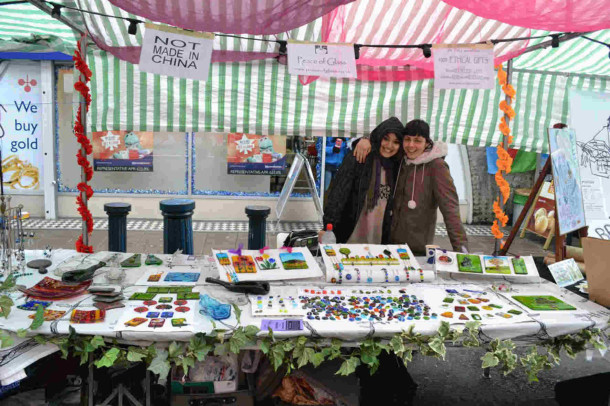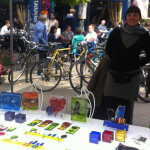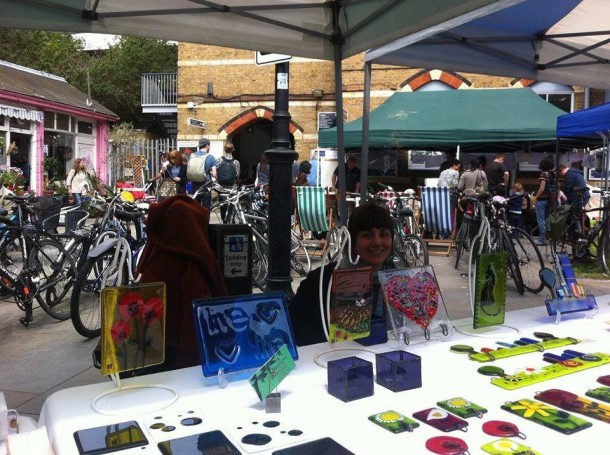
Italian-born Roberta ‘Roby’ de Caro playfully ruffles the blond locks of her adorable four-year old daughter Mia as she explains her venture into glass fusing. “I wanted my daughter to look at me and not just see someone who was unhappy and striving to make a living,” Roby says, “I needed her to see that I was happy with what I was doing.”
Fuelled by a strong attraction to the beauty of glass, but without any real experience, Roby started her artist career somewhat accidentally. “I have always liked glass: what you can do with it and the products that come out of it”, she explains. ”I never wear jewellery but as soon as a friend introduced me to this art form, I started making jewellery pieces. I didn’t do any classes or courses so everything was trial and error. But even my very first couple of pieces were good enough to be made into jewellery!”
Encouraged by her early successes and armed with past business experience from running her own music festival company with her former partner, Mia’s dad, Roby launched Peace of Glass four years ago.
Running a successful business as a single mum means life is perennially busy. She laughs, “I wasn’t expecting this business to be quite as full on, but I find that I am always strapped for time.” She adds, “Peace of Glass is only a small business but I still have to do everything that a large business has to do –accounts, promotions, looking for venues to sell my products, connecting with other artists, creating my designs…” she trails off as she looks at Mia running around the park. “It means that Mia often has to come with me to markets to sell my artworks.”

One such is Brixton’s Station Road Market, where Roby started out. “It was great and I loved it, it was just the right vibe for me”, enthuses Roby. “It was exciting; I had my first experiences of selling and the market there had only just started up. I loved the reggae music playing and the food there! I have the fondest memories of it.”
Last year Peace of Glass exhibited at a private garage space in Brixton Hill. Roby’s smile widens as she reminiscences. “It was really nice; jerk chicken wings cooked on site, music playing in the yard – I love that kind of relaxed vibe! I miss that!”
Whilst she no longer sells her wares in Station Road (“Sadly it’s lost its hand-made quality so fewer and fewer artists sell there.”) , Roby can now be found at the nearby Herne Hill Market and plans to sign up to Brixton’s creative Makerhood collective. Her art, meanwhile, clearly translates her unabating love for the area: “A lot of my art work is inspired by Brixton; the views from Brockwell Park for instance.”
Roby’s Peace of Glass is also a testament to how local businesses can help a fledgling company grow. “I received a £1,500 grant from Change Up, “she explains. “I presented my idea at a Dragon’s Den-type audition in front of a group of local companies who help people on low income start their own business. There is also an incubator period where I am able rent studio space at a low rate and it really does help to have my own space instead of using Mia’s bedroom!”
So, Roby’s little girl regained her bedroom and in the process may also have acquired an early interest in glass artistry. “She already has a toy kiln that she pretends to make glass jewellery in,” Roby flashes a proud smile.
But, Peace of Glass is much more than jewellery. The collection also features hair grips and cufflinks, in addition to freestanding pieces, wall art, sun catchers and bespoke pieces that are commissioned. And sometimes, even the artist is not entirely sure what to expect when she opens that kiln door.

“The process of making glass is always open to the unexpected!” Roby laughs.”Trapped bubbles during the annealing process in the kiln can cause holes so for bigger glass pieces you want longer annealing programmes to squeeze out air and minimise the risk of holes.” However, even potential disasters may be turned into strokes of genius. “Once I was working with another artist on a large mobile statement piece. I was commissioned to create big glass pieces in blue and red for a large mobile”, Roby explains. “At the time, I was learning how to work with bigger pieces and was very uncertain how to work the programming for my kiln.“
The pieces did not turn out as planned: they were marred of unsightly air holes. Roby was nervous for the other artist’s reaction as this was not at all what he had ordered. She needed have been. “The holes turned out to be the appeal of this mobile! It worked really well and this mobile is now a real attraction at Soho’s Ham Yard hotel where it hangs in the lobby!”
http://peaceofglass.co.uk/
Herne hill Market: http://weareccfm.com/HerneHill.html






